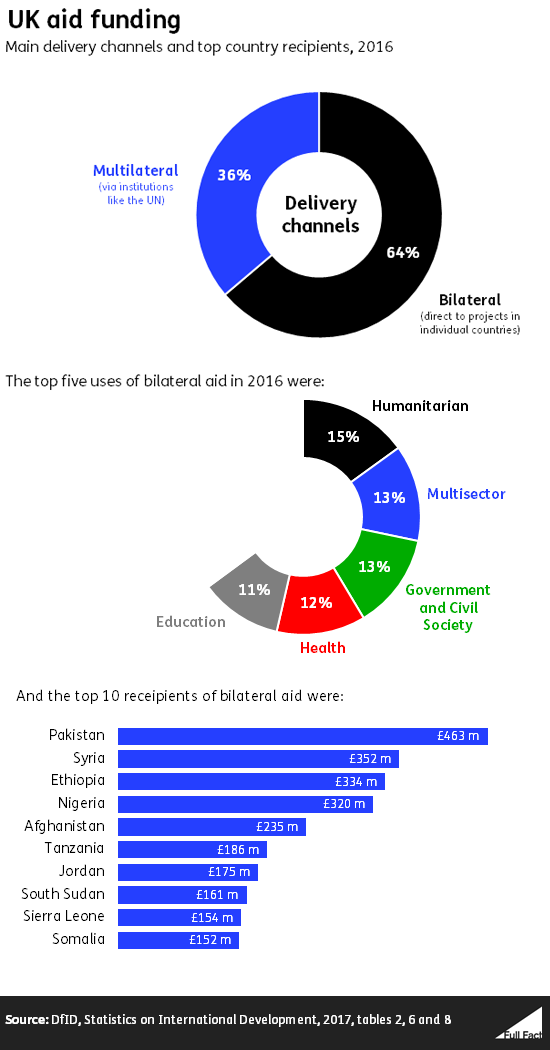UK spending on foreign aid
For every hundred pounds that’s made in the UK, seventy pence goes towards foreign aid.
Another way to say this is that the government has a target to spend 0.7% of the UK’s Gross National Income on overseas development aid each year. Gross National Income (GNI) is the UK’s annual output of goods and services, plus any income we get from abroad.
In 2016, the UK spent £13.4 billion on overseas aid, in line with the 0.7% target.
Because the UK economy is set to get bigger over the next few years the real value of development aid spending is expected to increase.
By 2021 we could be spending about £14.5 billion, based on the Office for Budget Responsibility’s forecasts and in 2016 prices. That’s a bit uncertain though; the amount we actually end up spending will depend on how much the economy grows.

Join 72,953 people who trust us to check the facts
Sign up to get weekly updates on politics, immigration, health and more.
Subscribe to weekly email newsletters from Full Fact for updates on politics, immigration, health and more. Our fact checks are free to read but not to produce, so you will also get occasional emails about fundraising and other ways you can help. You can unsubscribe at any time. For more information about how we use your data see our Privacy Policy.
Where does the target come from?
0.7% is the UN’s target for all developed countries and has been since 1970.
In principle the UK government has been signed up to the target since 1974 but it only achieved it for the first time in 2013.

In 2015 it was put into UK law, which means that the government has a legal duty to meet the 0.7% target. The legal duty can’t be enforced through the courts but the International Development Secretary has to explain herself to parliament if we don’t meet it.
Spending counts as overseas development assistance if:
- It goes towards a specific list of low and middle income countries, or institutions like the World Bank
- It’s spent by the government or government agencies
- It’s spent first and foremost to promote economic development and welfare
- It’s a grant, or loan that gives the borrower a much better deal than a loan at market rate
Where does the money go?
About 15% goes as humanitarian aid, or crisis relief, with the rest focused on strategic or long-term goals.
36% of the money goes via multilateral organisations, like the United Nations. The other 64% goes to programmes in specific countries as bilateral aid.
The five biggest recipients of bilateral aid are Pakistan, Syria, Ethiopia, Nigeria and Afghanistan. When it comes to continents, significantly more gets spent in Africa (51%) and Asia (42%) than anywhere else.
The Department for International Development (DfID) is responsible for most of the UK’s aid spending. They spend 74% of our ODA target; the rest is spent by other government departments and organisations.

How much is £13.4 billion?
The 0.7% target has had a long history of opposition, most recently from people who argue that the money would be better spent on domestic priorities, like social care or defence spending.
But it’s hard to say whether we’re spending ‘too much’ just by looking at the numbers alone.
As an example: £13.4 billion is roughly one tenth of government spending on health in England; from another perspective, it’s a bit more than all spending on police in England and Wales.
How do we compare internationally?
Only five other countries hit the UN’s 0.7% target for development spending in 2016.
